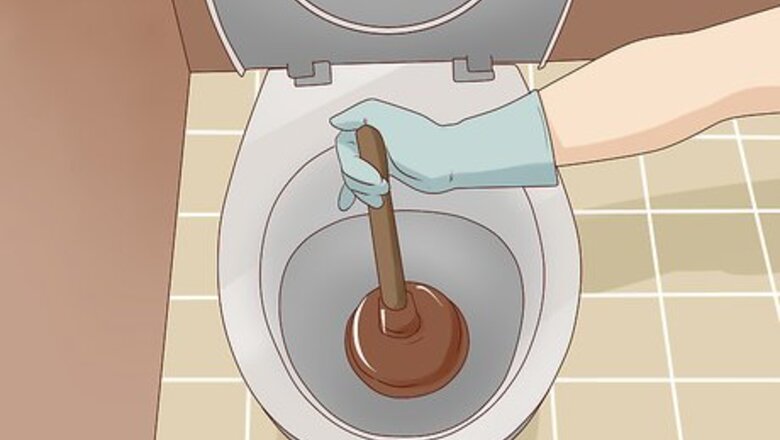
views
Trying Quick Fixes
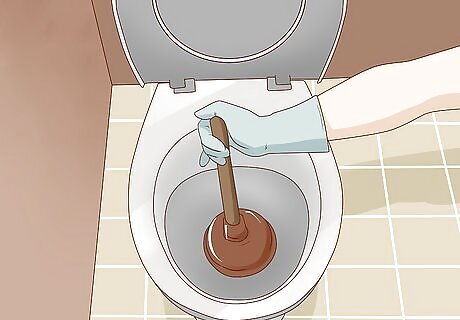
Use a toilet plunger if you can see the clog in the toilet. You can use a plunger to clear the clog just like in your toilet at home. Add some water to the toilet bowl if there isn’t any already. Then, put the plunger over the hole. Make sure it completely covers the hole. Pump the plunger up and down vigorously 15-20 times. Then, flush the toilet to check the drainage. If plunging once doesn’t solve the problem, you can repeat 2-3 more times, or try another method to clear the clog.
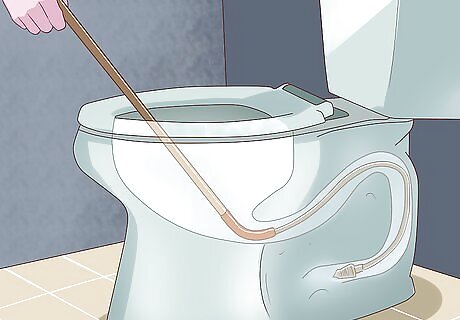
Try a toilet snake for extra narrow RV toilets. Sometimes a plunger doesn’t fit well into the toilets on some RVs. In this case, try using a slim toilet snake, sometimes also called an auger. This flexible coil of wire can snake through the toilet drain to break down an obstruction. Simply push it down the toilet until you hit the clog. Twist and push the snake to break the clog into smaller pieces so it can pass through to the black water tank. Breaking up the clog with a snake may take 15-20 minutes of maneuvering, so be patient.
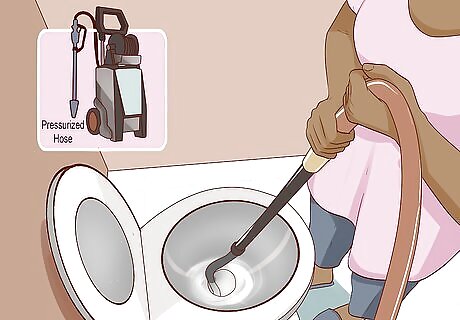
Clear a stubborn clog with a pressurized hose. Hook a hose up to a water source (don’t use the same hose you use for drinking water) and stick it into the toilet. You will probably need to snake it through a window of the RV. Turn it on full pressure to push the clog out of the pipe. Keep the hose running until your indicator says the black water tank is full. Attach a flexible tank wand to your hose for narrow pipes. A flexible tank wand is a flexible piece of tubing you can attach to the end of your hose. It’s narrow and bendy so it may be easier to navigate down your RV toilet if it is especially narrow.
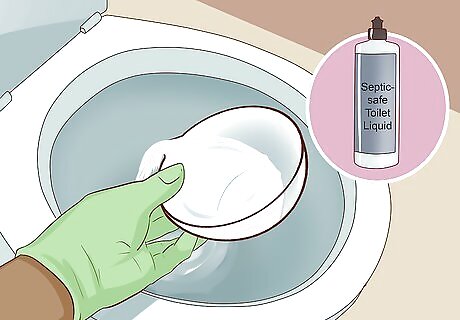
Buy a septic-safe toilet unclogger for a simple fix. Find a septic-safe toilet liquid at your local hardware store or online. These products are made to break down toilet paper and waste. Fill the toilet halfway with water. Pour the declogger in the bowl. After a couple hours, flush the toilet. Drive your RV around for 30 minutes or so to agitate the liquid in the black water tank. After, check the toilet again to see if the clog has cleared. Check the label to make sure your product is safe to use for septic systems. You can repeat the process once more if the clog is still there, but if after 2 applications of chemical declogger the toilet is still clogged, call a professional RV plumber.

Pour boiling water in the toilet if you don’t have any tools or chemicals. If you don’t have anything handy to unclog your toilet, use boiling water. Bring a medium pot of water to a rapid boil. Turn off your water connection. Then, open the toilet valve and pour the boiling water down the toilet. Repeat 2-3 times if necessary. Let it sit for a few hours or overnight before you try to flush the toilet again. Make sure the water really is boiling hot or it won’t be as effective at dissolving the clog. Drive the RV around for 15-20 minutes after you’ve poured the boiling water down the toilet to distribute the water around the black water tank to help clear up any buildup.
Emptying the Black Water Tank
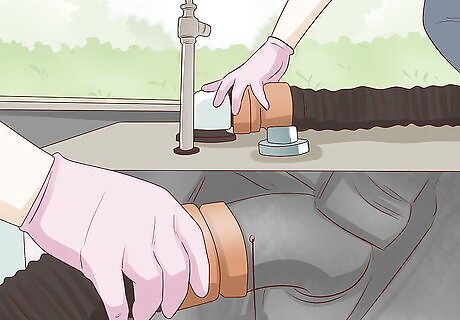
Attach a sewer hose to the dump station hole and the black water tank. Pull the RV into a designated dumping station. Attach a sewer hose to the dump station hole first. Then, take the cap off the black water tank on the outside of the RV. Attach the other end of the sewage hose to the black water tank. Use a clear connector to attach the sewage hose to the tank so you can see what is coming out and when it is empty.
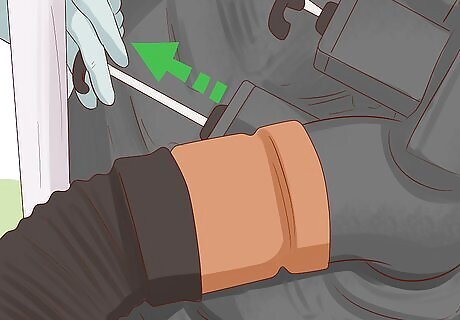
Open the valve to let the tank drain. Pull the valve next to the black water tank connection open. You will hear the noise of the liquid and solid waste flowing through the hose.

Close the valve and remove the connector slowly. When you can’t see or hear anything running through the hose anymore, close the valve. Slowly remove the connector to prevent anything leaking or spilling out from it. Finally, replace the cap on the black water tank and screw it on tight. Always make sure to close the black water tank valve after you’ve emptied it. If you leave it open, the liquids will drain out but the solid material will remain stuck, leaving you more susceptible to clogs. If you have a newer black water holding tank, there may be sensors inside it. The sensors are placed along the interior of the tank and gauge how full it is. The levels are indicated on a control panel so you can empty and clean the tank when it gets full. However, if there is waste or toilet paper blocking the sensors, they may be giving you inaccurate readings. In this case, you’ll need to clean out the tank.

Ensure all your valves are open if your black water tank won’t empty. When draining your black water tank, make sure your sewer line is hooked up to the tank and to the sewer and that all the valves are open. Some tanks have two valves. If all the valves are open and your tank still doesn’t drain, then you have a clog.
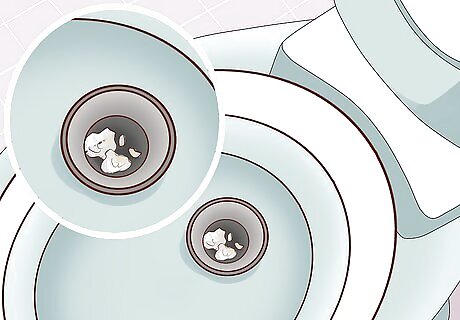
Look for the clog in the toilet after you’ve emptied the tank. Look into the toilet bowl and down the pipe. If you can see a buildup of toilet paper or waste, this is called a pyramid plug. If you can see it in the toilet pipe, your clog is in the toilet and not in the black water tank.
Preventing a Clog in the Future

Buy septic-safe toilet paper and reduce the amount you put in the toilet. Toilet paper can very easily clog RV toilets. Reduce the risk by buying septic-safe toilet paper and using less for each flush. Find septic-safe toilet paper it at your grocery store or online. Recycled toilet paper is often septic-safe and contains fewer chemicals to disrupt your septic system. It also breaks down easier.
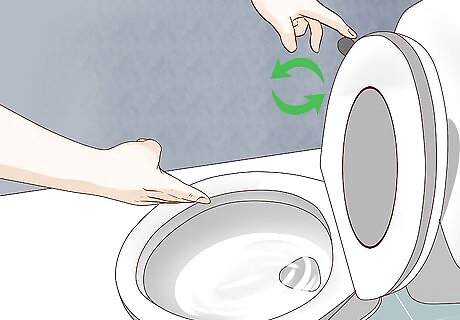
Use lots of water with each flush. Using lots of water each time you flush helps to break down waste and toilet paper so it can more easily travel into the black water tank. Simply fill up a large cup of water from the bathroom sink. Then, pour it into the toilet bowl before you use the toilet. When you flush, the extra water in the bowl will help the toilet paper and waste travel down to the black water tank more smoothly.
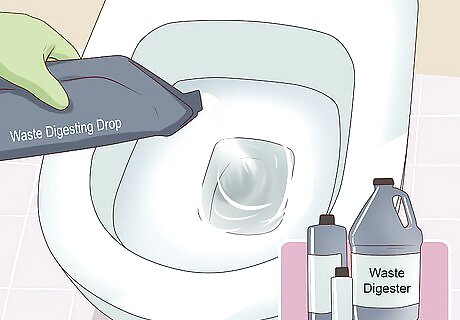
Add a waste digester to your black water tank to break down waste. Buy a waste digester at your local hardware store or online. They come in liquid and packet form. Read the label on the chemical you choose to find out how much to add. Generally, a couple of ounces of digester will be enough for a weekend trip. You can also buy waste digesting drops to add to the toilet bowl.


















Comments
0 comment